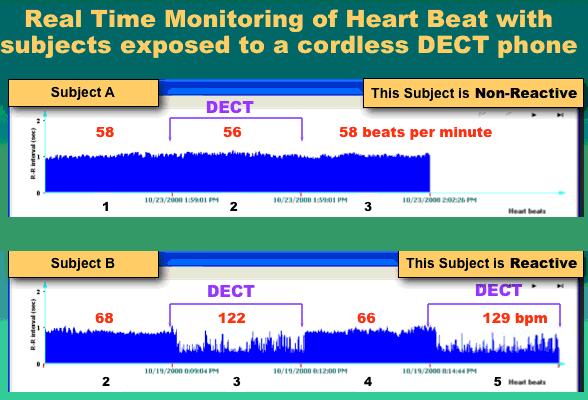The double-blind, peer reviewed provocation study of 25 people validates the condition complained of by increasing numbers of people across the globe today called 'electrosensitivity' (ES or EHS), demonstrating immediate effects on heart rate, almost doubling the heart rate in some cases. The study was led by Prof. Magda Havas of Trent University, Canada.
"What we found is what many people have said for a long time about devices that emit microwaves," stated Dr. Havas. "People don't just feel ill, their heart begins to race and this is measurable with medical heart monitoring devices."

exposure to a nearby portable phone. The heart rate immediately returned to
the baseline after the cordless phone was unplugged. This has also been
demonstrated using a WiFi router/Access Point
Havas' study in the European Journal of Oncology on heart rate variability was blinded, which means that the volunteers did not know when the phone was on or off. Forty percent (40%) of subjects had a moderate to severe reaction only when the phone's base station was on, and emitting microwaves. Those who responded experienced arrhythmia (irregular beats of the heart) and/or tachycardia (rapid heart rate). The symptoms were often accompanied by feelings of pain or pressure in the chest and anxiety that would appear and disappeared for no apparent reason.
This is the first study documenting immediate and dramatic changes in heart rate associated with microwave radiation exposure at levels of exposure well below (0.5%) federal guidelines in Canada and the United States (1000 microW/cm2, 10mW/m2). It points to the extraordinary inadequacy of current exposure guidelines to protect the public's health.
Not just DECT cordless but phones and WiFi too
Havas states, "While not everyone who is electrically sensitive responds in this manner, those who do will have difficulty being in environments where microwave radiation is present, which is virtually everywhere in our modern, wireless culture." She adds, "Cordless phones and cell phones as well as wireless computers and wi-fi networks generate this form of microwave radiation."
Additional common symptoms of EHS include headaches, fatigue, difficulty concentrating, poor short-term memory, difficulty sleeping, skin problems, tinnitus, nausea, and dizziness. Many of these symptoms are subjective and difficult to measure.
Havas' study heralds the ability of health practitioners to determine if cardiac irregularities might be triggered by electromagnetic radiation, using readily available assessment technology, before resorting to invasive or chemical symptom-suppressing cardiac therapeutics.
Dr. Havas is a world-renowned expert in electromagnetic fields. Her teaching and research is concerned with the biological effects of electromagnetic pollution including radio frequency radiation, electric and magnetic fields, dirty electricity and ground current. She is author of the BRAG Antenna Ranking of Schools Report, which teaches schools how radiation exposure from neighborhood cell phone towers and antennas can be assessed and remediated, Zory's Archives, an ongoing review of thousands of recently released studies on the biological effects of electromagnetic fields, dating back over a half century, drawn from U.S. government and military, and Russian and Eastern European, sources, and co-author of Public Health SOS: The Shadow Side of the Wireless Revolution.
On November 18th in San Francisco, Dr. Havas will present research at the Commonwealth Club of California demonstrating schools that use Wi-Fi may be putting students at great risk. The half-day program, "The Health Effects of Electromagnetic Fields", will feature experts from the U.S., Canada, Sweden, Norway and the U.K. They will review the state of the current science showing biological effects from cell phones, cell towers, wireless networks, dirty electricity and radiation-emitting 'Smart Meters'. A case will be presented for revision of worldwide exposure guidelines for radiation-emitting technologies.
This interview can be slow loading: havas-interview - Interview with Magda Havas.
2010 M.Havas, et al: Microwave Radiation Affects Autonomic Nervous System, Eu J Oncology Library Vol.5



the irregularities are in your thinking!